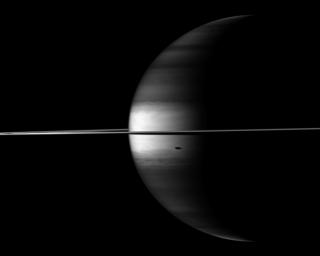The Cassini spacecraft's camera looks in near-infrared light at a dramatic view of Saturn, its ringplane and the shadows of a couple of its moons.
The large shadow south of the equator is that of the moon Tethys (1,062 kilometers, or 660 miles across). The small shadow near the limb of the planet, north of the equator, is the shadow of the moon Mimas (396 kilometers, or 246 miles across).
Saturn's northern and southern latitudes appear dark in this image because of the camera filter used. This view uses a spectral filter sensitive to absorption of certain wavelengths of light by methane in Saturn's atmosphere. The cloud tops in the northern and southern latitudes are at a slightly greater depth than in the equatorial region, and are underneath a layer of methane. This means that light travels along a longer path compared to the equatorial region as it enters the atmosphere, reflects off the cloud tops, and returns through the upper atmosphere to enter the camera. The light at near-infrared wavelengths thus passes through more light-absorbing methane at the northern and southern latitudes than at the equator, and so these latitudes are darker.
This view looks toward the northern, sunlit side of the rings from just above the ringplane.
The image was taken with the Cassini spacecraft wide-angle camera on Oct. 23, 2009 using a spectral filter sensitive to wavelengths of near-infrared light centered at 890 nanometers. The view was acquired at a distance of approximately 2.6 million kilometers (1.6 million miles) from Saturn and at a Sun-Saturn-spacecraft, or phase, angle of 110 degrees. Image scale is 149 kilometers (93 miles) per pixel.
The Cassini-Huygens mission is a cooperative project of NASA, the European Space Agency and the Italian Space Agency. The Jet Propulsion Laboratory, a division of the California Institute of Technology in Pasadena, manages the mission for NASA's Science Mission Directorate, Washington, D.C. The Cassini orbiter and its two onboard cameras were designed, developed and assembled at JPL. The imaging operations center is based at the Space Science Institute in Boulder, Colo.
For more information about the Cassini-Huygens mission visit http://saturn.jpl.nasa.gov/. The Cassini imaging team homepage is at http://ciclops.org.

 Planetary Data System
Planetary Data System












